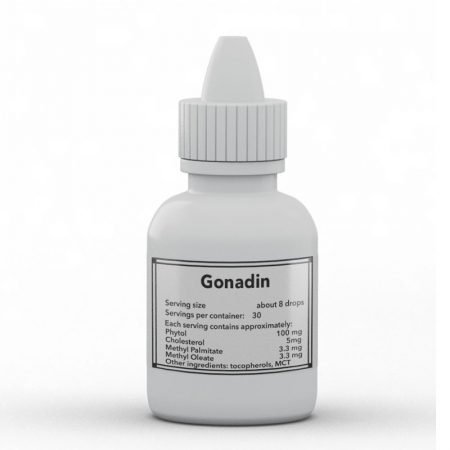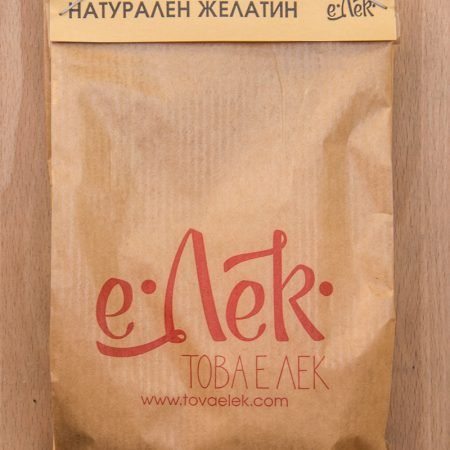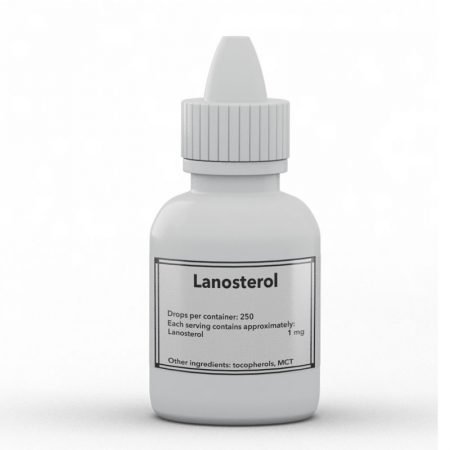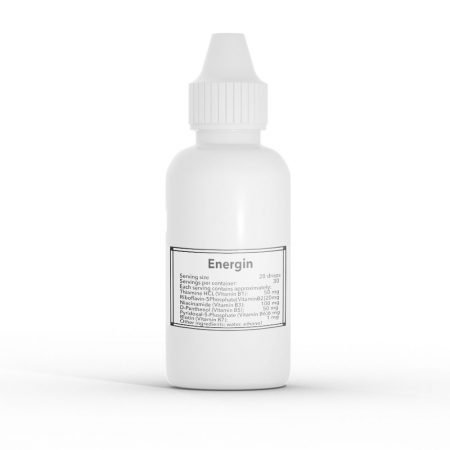Много интересно проучване, според което намаляването на функцията на половите жлези, наблюдавано при затлъстели/диабетични мъже, се дължи на хронично повишените нива на ендотоксин при тези хора. Проучването нарича този феномен (G)ut (E)dotoxin (L)eading to a (D)ecline (I)n (G)onadal function (GELDING) поради забележителното сходство във фенотиповете, причинени от кастрация и хронична ендотоксимия. Макар че в проучването се разглежда феноменът GELDING само по отношение на мъжете, в него се споменава, че има доказателства, че същият феномен се среща и при жените. А именно, доказано е, че жените са също толкова уязвими към предизвикано от ендотоксин затлъстяване и хормонален дисбаланс, колкото и мъжете, дори ако техните гонади (яйчници) произвеждат основно прогестерон (P4) вместо Т (въпреки че Т се произвежда и от жените). Изследването също така поставя вината за хроничната ендотоксимия директно в полето на мазнините. Както авторите ясно обясняват, диетата с високо съдържание на мазнини води до разрушаване на чревната бариера, възпаление и „подобрена“ абсорбция на ендотоксини чрез образуване на хиломикрони. Комбинацията от всички тези механизми оказва силно потискащо въздействие върху хипофизата и гонадите, което често води до достатъчно ниски нива на циркулиращите андрогени (или прогестерон при жените), за да се имитира кастрация.
Решенията, предложени в проучването, са в унисон с официалната медицинска догма – т.е. да се обърне затлъстяването и да се добавят пробиотици. Въпреки това, като се имат предвид позоваванията на самите автори на изследването на забележителната ефективност на антибиотиците, мисля, че ниски дози антибиотици, приемани 2-3 пъти седмично, биха били много по-подходящи за тежките случаи. Други мерки включват консумацията на неразтворими фибри, наситени мазнини (особено MCT поради антибактериалното им действие), медицински въглен и др. Вече има доказателства в подкрепа на тези извънборсови мерки от друго проучване, което публикувах наскоро. https://xenobg.com/dobavyaneto-na-dalgoverizhni-nasiteni-maznini-predpazva-chernia-drob-ot-alkohol/
Въпреки че горното проучване е фокусирано върху защитните ефекти на SFA върху черния дроб, в него подробно се обяснява, че защитните ефекти на SFA се дължат на възстановяването на чревната бариера, както и на намаляването на натоварването с ендотоксини. По този начин ефектът им е наистина системен антагонизъм на ендотоксините и не е свързан с някакво конкретно състояние. В по-практичен план, една супена лъжица кокосово масло (MCT) с всяко хранене или използването на повече наситени мазнини за готвене (масло, говежда лой, какаово масло и т.н.) би трябвало да е достатъчно, за да се възпроизведе дизайнът на горното проучване. Освен това други проучвания, публикувани в този блог, показват, че прилагането на андрогени и/или прогестерон може да има и пряк терапевтичен ефект. Андрогените, като например ДХТ, могат да потиснат възпалителните реакции, произтичащи от ендотоксина, и дори да блокират напълно активирането на TLR4. От друга страна, прогестеронът (и свързаните с него прегнанови стероиди) може да е в състояние дори да свързва и деактивира директно ендотоксина.
https://www.ncbi.nlm.nih.gov/pubmed/16317058
Освен това има данни, че хипогонадизмът допълнително изостря чревната пропускливост и възпалението и при такива условия дори „нормалната“ / „доброкачествената“ чревна флора може да бъде доста провъзпалителна и да нанесе хаос на системното здраве. Поставих „нормална“ и „доброкачествена“ в кавички във връзка с моя публикация отпреди около година, според която всъщност няма такова нещо като „доброкачествена“ или „полезна“ чревна флора, при условие че бактериалните видове, които я съставляват, са способни да произвеждат ендотоксин.
https://www.jci.org/articles/view/87430
По този начин патологиите на ендотоксемията и хипогонадизма изглежда образуват положителна обратна връзка и този порочен кръг обикновено може да бъде прекъснат чрез справяне с една от крайните точки – ендотоксемията или хипогонадизма. Като се има предвид, че прогестеронът може директно да свърже/деактивира ендотоксина, андрогените обръщат хипонадизма, а двата вида стероиди блокират възпалителните ефекти на ендотоксина, изглежда доста естествено да се използва комбинация от тези стероиди за синергични резултати. Ако се използват андрогени, смятам, че би било по-безопасно да се използват неароматозни видове като DHT или негови производни като дростанолон, провирон, стенболон и др. Ароматизиращите се андрогени лесно се превръщат в естроген в среда с високо съдържание на ендотоксини. Естрогенът е известен индуктор на чревната пропускливост, както и индуктор на възпалителни пътища, така че използването на ароматазен андроген като Т може да влоши много ситуацията. В комбинация с прогестерон употребата на Т вероятно е по-малко опасна, отколкото използването му самостоятелно, поради инхибиращите ароматазата свойства на прогестерона. Въпреки това, ако са налице по-безопасни варианти (като например семейството на DHT стероидите), тогава ИМО няма причина да се поема риск с ароматазни стероиди.
https://www.ncbi.nlm.nih.gov/pubmed/31689143
“…DHT levels in serum did not differ between the groups, but DHT levels in the liver and seminal vesicles were increased in GF (germ-free, no endotoxin) compared to CONV-R mice (figure 8a). T levels in serum did not differ between the groups and T levels in liver were increased in GF compared to CONV-R mice (figure 8b) while A-dione values did not differ between the groups in serum or the evaluated extra intestinal tissues (figure 8c). GF males had larger testes than CONV-R males (table 4).”
https://www.ncbi.nlm.nih.gov/pmc/articles/PMC5899218
https://www.ncbi.nlm.nih.gov/pmc/articles/PMC4918028
“…The central key to the GELDING theory of male hypogonadism is that activation of the immune system by an obesity related trigger is then capable of impairing testicular function. Several large epidemiological studies have already reported an association between male obesity, markers of inflammation such as CRP and white cell count (WCC), and a reduction in serum testosterone [25–28]. As testosterone is known to be immune-suppressive [29, 30], this association between obesity related inflammation and lower levels of serum testosterone has previously been suggested to be caused by a reduction in testosterone’s immune-suppressive action [26]. However, observational studies are incapable of proving cause and effect, nor the mechanistic direction of such associations. Therefore we contend that the reduction in testosterone’s immune-suppressive effect is not the underlying cause of increased inflammation seen in obese men, but rather the reverse. Specifically, obesity triggers an inflammatory response that in turn impairs testicular function, and that this results in both a reduction in testosterone production and impaired spermatogenesis.”
“…Obesity, and a diet high in fat or calories that is typically consumed by obese individuals, has been reported to cause a breakdown in the normal mucosal barrier function, leading to the passage of gut bacteria into the systemic circulation, initiating a chronic state of inflammation [34, 35]. Gram negative bacteria, which comprise 70 % of the total bacterial load in the human gut [36], contain a potent immune stimulant in their cell wall referred to as lipopolysaccharide (LPS) or endotoxin. Animal experiments and human observational studies have shown that consumption of diets containing either high fat or high number of calories leads to significant changes in gut bacterial populations and increases in the circulating levels of plasma endotoxin [37, 38], implying a breakdown in gut mucosal wall integrity and the passage of gram negative bacteria into the systemic circulation. Interestingly, the magnitude of this “metabolic endotoxaemia” is reported to be more pronounced in mice placed on a high fat diet than an isocaloric high carbohydrate diet, suggesting that dietary fat is more efficient in transporting bacterial endotoxin from the gut lumen into the circulation, possibly mediated by transfer of endotoxin across the intestinal wall in lipid laden chylomicrons [34, 38]. Furthermore, a high fat diet is reported to unfavourably alter the gut microbial composition, leading to an increase in intestinal permeability due to disordered tight junction proteins (zonulin, occludin) [39], and a reduction in the colonic mucous barrier [40]. Confirming the importance of gut microbiome in facilitating endotoxaemia, the administration of antibiotics to obese mice or modification of their gut microbiome with prebiotic fibre, have both been reported to result in a decline in circulating plasma endotoxin levels [39, 41, 42].”
“…Cross-sectional studies in humans have also reported an elevation in circulating levels of endotoxin [38, 43, 44], or indirect markers of endotoxin (LBP) exposure [45, 46], in obese individuals. Obesity has also been shown to be associated with changes in the human gut microbiome, with several investigators now reporting a reduction in the beneficial genus bifidobacterium in the faecal samples of obese individuals [47, 48]. Since bifidobacterium are known to metabolise dietary fibre, producing short chain fatty acids (SCFA) that “feed” the host intestinal mucosa, and enhance the production of mucus and maintain tight junction barrier function [49], it is likely that any reduction in bifidobacterium numbers due to obesity will result in a breakdown in intestinal barrier function and endotoxaemia. Furthermore, obese men have also been shown to have a more marked post-prandial endotoxaemic and inflammatory (IL-6) response to a standard meal containing 40 gm of fat than their age matched lean counterparts [34, 50]. As such, we propose that changes in the intestinal microbiome caused by obesity, and the associated “poor diet”, result in a breakdown in the mucosal barrier function of the gut (so called “leaky gut”), and that this results in the passage of gram negative bacteria into the circulation (metabolic endotoxaemia) which triggers a chronic state of inflammation that impairs testicular function.”
“…However, studies in women have confirmed an association between endotoxaemia and a reduction in the ovaries capacity to produce the female sex steroid hormone progesterone [46]. Furthermore, there is abundant animal evidence suggesting that endotoxin (LPS) does have the capacity to impair testicular function. Firstly, the experimental administration of LPS to rats, sheep, cattle and non-human primates has been shown to decrease the frequency and amplitude of LH pulses by suppressing both hypothalamic and anterior pituitary function [51], thereby reducing the pituitary drive for Leydig cells to produce testosterone. Secondly, animal studies have also confirmed that Leydig cells express the TLR4 for endotoxin [52], and that experimental administration of LPS directly inhibits Leydig cell production of testosterone [52–57]. The direct inhibition of androgen production by endotoxin is most likely mediated by a reduction in Leydig cell expression of steroidogenic acute regulatory (StAR) protein activity [58], a protein that plays a key role in the initial transfer of cholesterol into mitochondria where it is later converted into testosterone.”
“…The activation status of testicular macrophages is also likely to play a role in testosterone production. Leydig cells and macrophages are normally in close physical contact within the testicular interstitium, and under normal conditions these macrophages play a key role in Leydig cell development as they provide essential growth and differentiation factors [58]. However, under immune-stimulatory conditions, as occurs with metabolic endotoxaemia, macrophages produce pro-inflammatory cytokines such as IL-1 and TNFα, plus reactive oxygen species (ROS), all known to reduce steroid hormone production by the adjacent Leydig cell [55, 57, 58]. Furthermore, Leydig cells themselves have been reported to produce inflammatory cytokines (IL-1β, TNFα and IL-6) when exposed to LPS [52], which would result in a further amplification of the neighbouring macrophages state of activation. Interestingly, dampening inflammation using TNFα blocking antibody therapy has been shown to normalise serum testosterone levels in spondylo-arthritis patients [59], highlighting the potential role for inflammation in decreasing testosterone production.”
“…Obesity related endotoxaemia is likely to impair sperm production and function, both directly and indirectly. Firstly, high intra-testicular levels of testosterone are required for normal sperm production. Inadequate levels of testosterone disturbs Sertoli cell function, leading to retention and phagocytosis of mature spermatids [60] and impaired epididymal function, both potentially reducing sperm number and quality. Secondly, human sperm have been reported to express both the TLR4 [61] and the CD14 co-receptor for LPS [62], as well as directly responding to LPS exposure by increasing their production of IL-6 [63], initiating sperm apoptosis and a decline in sperm motility [61, 64–66]. Furthermore, as semen is known to contain both LPS and leukocytes [61], it is not surprising that endotoxin exposure would increase seminal leukocyte reactive oxygen species (ROS) production and result in sperm oxidative damage [67, 68]. Seminal plasma neopterin, a marker of macrophage activation status, has been reported to be increased in obese men [69], with seminal plasma neopterin also being positively correlate with sperm oxidative stress, DNA damage and apoptosis [69]. This finding, together with previous publications linking impaired sperm production with an increase in testicular macrophage density [70, 71], all support the concept that a trigger for inflammation such as metabolic endotoxaemia has the potential to impair spermatogenesis and sperm function.”
“…Firstly, obesity and a high fat diet have both been conclusively linked with changes in gut microbiota, increased intestinal permeability and the resultant leakage of bacterial endotoxin from the gut lumen into the systemic circulation (metabolic endotoxaemia) [38, 43–46]. Secondly, animal studies have clearly shown that exposure to endotoxin does result in a reduction in testosterone production, both indirectly (impaired pituitary LH drive), and through direct inhibition of Leydig cell function [51–57]. While similar studies have not yet been conducted in men, it has been reported that serum testosterone levels do fall during times of infectious endotoxin exposure [86], as anticipated by the GELDING theory. Furthermore, multiple large observational studies have now linked increased levels of inflammation (raised CRP and WCC) with lower serum testosterone [25–28].”
“…The GELDING theory is entirely novel in that for the first time it provides a clue to what may be initiating inflammation and impairing testicular function in obese men- gut derived endotoxin. If proven correct, the GELDING theory opens up a whole new scope for treatment of the hypogonadal male through modification of his gut microbiome and intestinal permeability. For example, obesity related hypogonadism becomes more common with increasing age, causing significant physical and psychological impairment. However, modification of the gut microbiome using probiotics has already been reported to reverse this age-related hypogonadism in rodents [112], raising exciting therapeutic potential for older men.”
Източник:
- Колко пресни портокала са ви необходими, за да изчистите черния си дроб от мазнини?Ако имате омазнен черен дроб, включването на пресни портокали в диетата ви може да ви помогне да възстановите здравето на черния си дроб. Това става ясно от малко италианско проучване. Италиански биохимици, свързани с Националния институт по гастроентерология – IRCCS Saverio de Bellis, набират 62 души с метаболитна дисфункция, свързана със стеатозна болест на черния… Read more: Колко пресни портокала са ви необходими, за да изчистите черния си дроб от мазнини?
- Хроничният стрес понижава допамина и причинява психични заболяванияДоказателствата за ролята на хроничния стрес в почти всички здравословни състояния, за които лекарите имат наименование, продължават да се трупат. За съжаление, дори в това последно проучване учените продължават да настояват, че има някаква мистериозна и неизмерима разлика между хроничния стрес, който „увеличава риска“ и „причинява“ патология. Същите тези учени обаче нямат проблем да заявят… Read more: Хроничният стрес понижава допамина и причинява психични заболявания
- Естрогенът и кортизолът, а не андрогените, потискат имунитетаВ биологията на възпроизводството има една много известна теория, която все още се смята за доминираща в тази област. А именно, че мъжете трябва да приемат баланса между нивата на андрогените и имунитета. Тя е известна като хипотеза за увреждане на имунната компетентност (ICHH). По-високите нива на андрогените, според теорията, позволяват на мъжкия да н(физически)… Read more: Естрогенът и кортизолът, а не андрогените, потискат имунитета
- Инхибирането на ароматазата (за намаляване на естрогена) може да доведе до лечение на рак на стомаха.Още едно проучване, което доказва причинно-следствената връзка между естрогена и рак, смятан за хормононезависим. Ракът на стомаха е една от водещите причини за смърт от рак в световен мащаб и особено в азиатските страни. Счита се, че е много труден за лечение и повечето пациенти се диагностицират в стадии, в които операцията не е подходяща.… Read more: Инхибирането на ароматазата (за намаляване на естрогена) може да доведе до лечение на рак на стомаха.
- Потиснатият имунитет, а не вирусите (HPV), може да е причина за рака на кожатаНаскоро публикувах няколко теми, свързани с имуносупресията и рака. Ето две от тях, които дават добър преглед и свързват имуносупресивните ефекти на ПНМК, естрогена и кортизола със защитните ефекти на витамин А, Е, D, прогестерона и др. https://xenobg.com/pnmk-sa-imunosupresivni-a-gladuvaneto-i-ogranichavaneto-na-proteinite-veroyatno-nanasyat-oshte-po-golyama-vreda/ https://xenobg.com/vitamin-d-mozhe-da-spre-rastezha-na-melanoma/ Въпреки натрупващите се доказателства, че именно потиснатата имунна система позволява на рака да се образува и… Read more: Потиснатият имунитет, а не вирусите (HPV), може да е причина за рака на кожата
- Витамин К може да лекува левкемияОще едно чудесно проучване, което демонстрира както терапевтичния потенциал на витамините, така и метаболитния/редокс характер на рака. Както споменах в някои от моите подкасти, витамин К2 (MK-4) понастоящем е в процес на клинични изпитвания за лечение/предотвратяване на редица различни видове рак, особено рак на черния дроб и т.нар. миелодиспластични състояния, които обхващат всички видове рак… Read more: Витамин К може да лекува левкемия
- Витамин D може да спре растежа на меланомаСтрахотно проучване, което потвърждава неотдавнашната ми публикация за това, че избягването на слънчевата светлина е толкова вредно за здравето, колкото пушенето на кутия цигари на ден. В края на краищата, без слънчева светлина няма да има голям синтез на витамин D, а допълнителният прием не е ефективен за много хора поради различни фактори, включително наднормено… Read more: Витамин D може да спре растежа на меланома
- Повишеният синтез на мастни киселини (FAS) е просто признак за недостиг на кислород / нисък метаболизъмСамо една бърза публикация за проучване, което дава представа за това как повишеното окисление на мастните киселини може „парадоксално“ да доведе и до повишен синтез на мастни киселини, като по този начин води до порочен кръг, който най-често се наблюдава при диабет и рак. В една от последните ми публикации се обсъждаше много по-ново проучване,… Read more: Повишеният синтез на мастни киселини (FAS) е просто признак за недостиг на кислород / нисък метаболизъм
- ПНМК са имуносупресивни, а гладуването и ограничаването на протеините (вероятно) нанасят още по-голяма вредаКакто споменах в един от първите подкасти с Дани Роди, ролята на ПНМК като имуносупресори всъщност е добре позната в индустрията за трансплантации на органи. В някакъв момент през 80-те години на миналия век дори е имало търговски продукт на основата на ПНМК, продаван на болниците като част от така нареченото решение за „пълно парентерално… Read more: ПНМК са имуносупресивни, а гладуването и ограничаването на протеините (вероятно) нанасят още по-голяма вреда
- Хората имат подобна на саламандър способност да възстановяват хрущялиЗаглавието говори само за себе си, но авторите на проучването правят злощастното и неудачно заключение, че макар и да можем да възстановим хрущяла, не можем да възстановим крайниците си. Е, многобройните изследвания върху животни, които публикувах в последния материал, не са съгласни с това и сочат както високия метаболизъм, така и прогестерона като мощни регенеративни… Read more: Хората имат подобна на саламандър способност да възстановяват хрущяли













